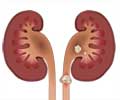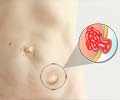Incisional Hernias - Causes
Incisional hernias are caused due to stretching of scar tissue that forms after surgery and occurs due to constant pressure of abdominal contents on the scar.
Not all abdominal surgeries will lead to incisional hernia, but any full thickness abdominal incision can leave a weakness and make that area prone to hernia. Usually a proper closure and adequate post-operative measure avoids the problem. However, sometimes despite the best care, a person may develop the hernia and at other times it can be predicted depending on the patient’s general condition and the type of surgery performed.
Normally there are three layers covering the abdominal contents. These include a thin inner sheet called the peritoneum, a thick middle layer of muscles and the third outer layer – the outer skin. An incisional hernia forms usually due to weakness of the thick layers of muscles. There are various factors that can lead to the weakness or hernia formation and these factors generally can be broadly looked at as –
- Mechanical factors
- Patient-related factors
- Or Technical factors
Mechanical factors
Mechanical factors increase the intra-abdominal pressure after an operation and causes the hernia. Common causes include-
- Chronic cough- Coughing and vomiting are associated with a brief but significant increase in intra-abdominal pressure. This, again, leads to too much tension on the incision and possible breakdown of the incision.
- Lifting heavy weights- Obviously, if a patient lifts something too heavy immediately after the operation, he or she can also tear the incision and cause a hernia.
- Postoperative ileus- This occurs when the abdomen becomes distended because the intestines are not working properly after an operation. The swelling of the intestines increases the pressure in the abdomen and places tension on the incision. The tension then leads to defective healing.
- Straining to move bowels after surgery– Constipation is another culprit for hernia formation. During the post-operative period and for a few months afterwards one should avoid straining while moving the bowels.
Patient-related factors
Patient factors are diseases or illnesses that impair wound healing. The three principle examples are infection, malnutrition and diabetes.
- An infection of the surgical incision impairs wound healing. In part, this may be because sutures and tissues are destroyed by the infection.
- Malnutrition leads to poor wound healing because the nutrients necessary for good healing are present in insufficient quantities or are completely absent. Malnutrition may be a generalized condition in which proteins and energy are deficient, or a specific condition, such as lack of a specific vitamin. Scurvy, which results from vitamin C deficiency, is an example of a deficiency in one key nutrient that leads to poor wound healing.
- Diabetes Mellitus also impairs wound healing and is associated with a higher incidence of hernia formation than the general population. Diabetes affects wound healing by impairing the function of white cells, predisposing the patient to infection and limiting the ability of new blood vessels to grow into the healing area.
- Chronic illness of any type also affects wound healing through problems with nutrition and a general increase in inflammation.
Technical factors
The principle technical factor that leads to an Incisional hernia is too much tension on the incision when it is closed. This can lead to:
- Tearing- Tension sutures can tear through the tissue when added stress is placed on it, such as during coughing or lifting.
- Decreased blood supply- Excessive tissue tension can also reduce blood flow to the tissue around the suture itself. This leads to breakdown of the tissue and the suture pulls through.
Other technical factors unrelated to tissue tension may also play a role. For example the sutures may have been placed in weak tissue, the wrong layer of tissue may have been sutured, the suture may have broken or the suture may not have been strong enough for the tension it is later subjected to.














